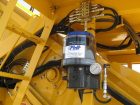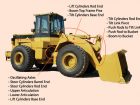
Products & Equipment
Heavy Equipment
Understanding the advantages of automatic lubrication systems
January 1, 2018 By Mike Deckert and Gabriel Lopez

Successful companies are constantly seeking new solutions and advanced technology to reduce costs, minimize downtime and maximize productivity. Can lubrication play a role in that? You bet!
Studies have shown that improper lubrication accounts for 53 per cent of all bearing failures, a major cause of equipment downtime and significant unnecessary maintenance costs including, replacement bearings, labour to repair or replace bearings, unscheduled downtime and the impact on meeting customer delivery commitments. Primarily, these failures are caused by contamination of bushings by dust, dirt and moisture or inadequate amounts of grease applied to bearings.
Inefficient manual lubrication practices can also result in over-lubrication, which brings its own indirect, but very real costs, including wasted lube, environmental issues, safety or housekeeping issues and higher labour costs.
Automatic Lubrication Systems (ALS) help eliminate these unplanned and unnecessary expenses. An ALS automatically lubricates multiple points on a machine from a centralized pump/control unit, mounted in an easily accessible location. Specifically for mobile construction equipment, a system dispenses small measured amounts of grease at frequent intervals, while your equipment is operating, maintaining a uniform supply of grease in the bearing at all times and a consistent grease seal to prevent dirt and contaminants from migrating into bearings. This is in contrast to the feast and famine conditions often associated with manual greasing, where greasing is done “when there’s time”.
The benefits of using ALS are many:
- Safety – Personnel safety in today’s workplace is a key consideration. An ALS reduces or eliminates climbing over and under machinery or into difficult-to-reach areas.
- Efficient lubrication – An ALS applies grease while the machine is running, which means less downtime, and because the bearings are turning, all the load bearing surfaces are continuously being exposed and get much better grease coverage.
- Better lubrication – Applying grease is most effective when it`s dispensed in small, measured amounts over short, frequent intervals. Unfortunately, tight deadlines, manpower constraints or location of equipment often make this method of greasing impossible. Equipment gets greased when it’s available and there’s time and somebody available to do it. An ALS addresses this.
- Better housekeeping – Many traditionalists over-lubricate by pumping grease in until it oozes out of the bearing. As previously stated, frequent and small, measured amounts will give your bearings the best protection. In addition to no over/under lubrication, you get less spillage and leakage. The end results are less grease wastage and less mess on your equipment, site, parking lot, etc. Appearance aside, safety (danger of slipping) and environmental issues are even more important.
- Less downtime, reduced maintenance costs and bearing replacement – Time and manpower constrains often make it nearly impossible to keep up with the greasing requirements of equipment. The preventative maintenance provided by an ALS is absolutely key to reducing maintenance costs and minimizing downtime by extending the life of the many pivots, bushings and components on the equipment. There are also fewer replacement parts to stock.
- Increased overall productivity – Resulting from an increase in machine availability and reduction in downtime due to breakdowns or general maintenance.
- Longer equipment life and higher resale value – Because bearing areas are consistently protected and your machinery, in general, is better maintained.
- Helps the environment – Less premature wear of bearings and other components means less landfill. Also, since you’re not over-greasing, you’re depleting fewer resources from the environment and you’re not contaminating the environment with dripping grease.
ALS systems vary in quality and design by manufacturer, but typically consist of five main components:
- Controller/timer – activates the system.
- Pump and reservoir – stores and provides the lubricant to the system.
- Supply line – the line (typically stainless steel or nylon material) through which lubricant is transferred from the pump to the metering valves.
- Metering valves – component that measures/dispenses the lubricant to the application points.
- Feed Lines – lines that connect the metering valves to the application points (typically stainless steel or nylon material).
Operation begins when the controller/timer sends a signal to the pump starting the lube cycle. The pump station automatically delivers lubricant through a supply line to multiple metering valves that then measure and dispense a predetermined amount of lubricant through feed lines to the individual lubrication points.
System sourcing
When sourcing a system, make sure you’re asking the right questions, so you can get the system that’s right for you. The first thing to know is that there are different operating principles by which ALS are designed. The two most common types used on mobile equipment are Series Progressive and Parallel.
In a progressive system, a pump delivers the grease to the grease points via progressive metering valves custom-sized for each application point. Grease flows through a primary valve which redirects to multiple secondary valves, and finally through feed lines to the ultimate application points. The nature of this system is such that if any line/bearing is not taking grease the entire system shuts down and there is (in a properly designed system) visual indication that there is a problem. This allows the operator an opportunity to take action before any damage occurs to the bearing.
In a parallel type system, grease flows from the pump through a single supply line to multiple branches of injectors. The injectors operate simultaneously but are independent of each other. Each injector serves one grease point and may be adjusted to deliver precise amounts of grease or oil. In a parallel type system, only main line pressure is monitored, so if any feed line or bearing is not taking grease, the remainder of the system will continue to function normally, but the grease starved bearing may be lost.
Once you’ve decided on the type of system you want, other questions you would want to ask could include the following:
1. Does the pump package include a high-pressure, inline, grease filter?
A filter prevents the introduction into the distribution lines of contaminants that can cause system failure and costly component replacement and labour costs. It is not always supplied as standard – it must be specified.
2. Are the hose and fittings standard NPT thread?
Some system manufacturers use metric hose ends and fittings. Adapters are required to adapt to NPT bearing inlets causing increased costs and labour and possible delays during servicing if you are not prepared with the proper replacement fittings.
3. Does the system include a pressure gauge?
A pressure gauge allows for visual monitoring of the system pressure during regular maintenance inspections. It is not always supplied as standard – it must be specified.
4. Do the metering valves incorporate high-pressure, manual grease fittings?
Having a manual grease fitting at every metering valve allows for easier trouble-shooting, servicing, priming and flushing of grease lines. Not having a manual grease fitting means lines have to be disconnected to perform many of these tasks, substantially increasing labour costs. Many manufacturers either do not include grease fittings, or use standard grease fittings, which leak when faced with the high back pressure of a blocked line.
5. How do you know if a bearing is not getting grease?
With a progressive system, the metering valves work in series to each other. Some systems incorporate a cycle indicator pin (CIP) at the master valve assembly to provide visual confirmation of system cycling every time. If any line/bearing is not taking grease the entire system shuts down and the CIP tells the operator that there is a problem, so action can be taken before any damage occurs.
In a parallel type system, metering valves operate independent of each other and only main line pressure is monitored, so there is no indication (related to pressure) if each individual feed line is operating. For some manufacturers’ systems, if any feed line or bearing is not taking grease, the only visual indication is the lack of grease at the bearing point. In a properly designed system, there are indicator pins on every injector which move in and out as grease is dispensed to visually confirm each individual feed line is operating.
6. Does the system require special grease?
Some systems typically used for on-road vehicles have a low maximum operating pressure, with small diameter hose/tubing and can only handle grease 000 through 0 (consistency of honey). If temperatures fall below -10 C, the #0 grease becomes too hard to pump and thinner grease must be used. In warmer climates, the thinner grease will drip away, causing potential damage to the bearings and environmental issues. Systems with higher maximum operating pressures will take grease 000 through EP2 and can use any No. 2 chassis grease rated to perform down to -25 C. Also important to note, some manufacturers require you to purchase grease directly from them in order to warranty the system. Others have no restrictions on the brand of grease, which allows you to use your standard in-shop grease and considerably reduce inventory and costs.
In closing, an automatic lubrication system is a valuable tool in reducing the direct and indirect costs resulting from inadequate lubrication, but you need to understand how it works, the different types of systems available and which type best suits your company’s operation style. When sourcing an ALS, ask the questions outlined in this article and you’ll be on your way to purchasing a tool that will help maintain your equipment, reduce your costs and increase productivity for years to come.
Mike Deckert is the vice-president of FLO Components and a member of the faculty, board of directors and advisory committees for Heavy Duty Equipment Technician and Heavy Duty Equipment Operator at Conestoga College and an instructor of the Lubrication School at Mohawk College. He has more than three decades of experience on the topic of lubrication.
Gabriel Lopez is the marketing specialist for FLO Components.
Print this page


